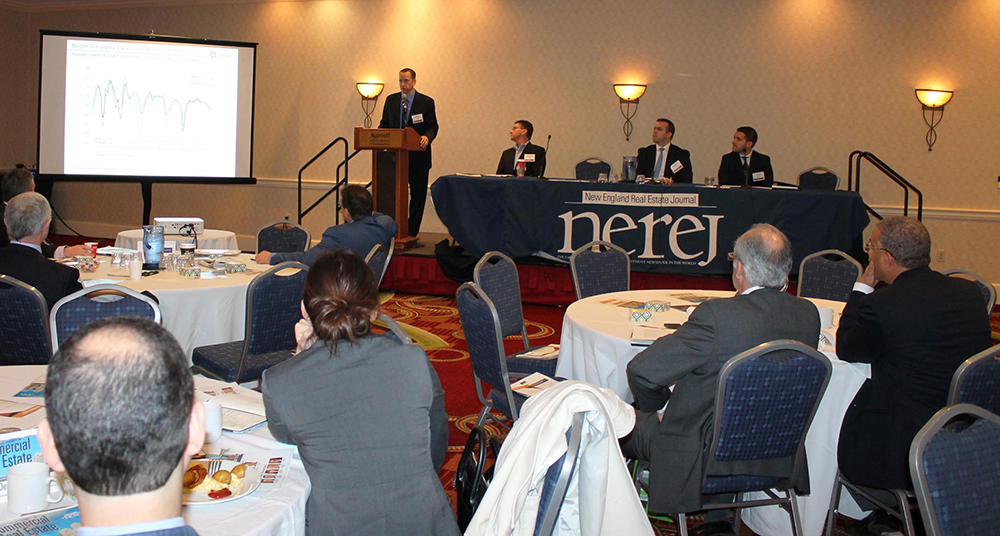Newton, MA As 2016 heads towards its conclusion, many of the positive factors that have made the Greater Boston commercial real estate market one of the strongest in the nation remain intact. A booming economy that has seen unemployment in Massachusetts drop below 3% (its lowest level since 2001), spurred rent growth and declining vacancies in the office, industrial, lab and apartment markets. But as the year draws to a close, some of the momentum of the past few years may be waning, according to the panels of experts at the New England Real Estate Journal’s Commercial Real Estate 2017 Forecast Summit, held recently at the Boston Marriott Newton.
The first panel, moderated by Mark Hickey, commercial real estate consultant for CoStar Portfolio Strategy, included Evan Griffith, director with the national multi-housing group & special assets services at Marcus & Millichap, and Patrick Joyce, a senior associate specializing in leasing and sales for the suburban brokerage team of CBRE/New England.
Hickey kicked off the proceedings by providing an overview of the office and industrial sectors as well as the multifamily market, emphasizing that, “The outlook for commercial real estate really depends on property type.” Despite the robust economy, there is a “continued mild weakening” of rents in the apartment market, due to increased construction in recent years. The overall vacancy rate may begin to increase, Hickey opined, and in markets that have had a significant amount of construction, Greater Boston can expect a slight decline in asking rents, particularly in class A product. There is also a trend towards increasing concessions such as free rent for a month (or more) during the course of a lease. The areas most at risk for slowing rent growth are Downtown/Chinatown, Seaport, and the Cambridge markets. However, submarkets that have not seen a lot of construction will continue to see rent growth of 2-3%, especially B and C apartments. In terms of investment sales of multifamily properties, Hickey said, “I think we’re definitely going to see a flattening out of pricing in 2017.”
In the office market, the robust rent growth in recent years – particularly in the downtown and select suburban markets – will begin to slow, even as vacancies continue to decline. By late 2017 to early 2018, absorption and rent growth will begin to flatten. Pricing for investment sales in the office market – despite a handful of $1,000 per s/f sales in Boston and Cambridge in 2016 – will also level out. “We’re definitely at the top of the market now,” said Hickey. One sector that is heating up as we head into 2017, however, is the industrial market. Since 2010, vacancy rates for this property type have plummeted from 10% to just over 4% in the region, as e-commerce drives the demand for distribution centers and warehouse space.
Joyce gave a comprehensive rundown of the changing landscape of suburban leasing in Greater Boston. While activity in Central 128 (Needham to Burlington) remains strong overall, most submarkets continue to struggle in varying degrees. There is a strong in-migration underway for companies from the suburbs to Boston and Cambridge, as firms chase (millennial) talent, driving landlords to re-invest and re-position their properties, adding the live, work, play dimension. Subleasing activity is affecting the suburban market, both as a result of mergers and acquisitions (such as Endurance acquiring Constant Contact), as well as companies such as VistaPrint and Wolverine engaging in “defensive leasing” – taking more space than currently needed to accommodate future growth, and putting a portion of it back on the market.
On the multifamily side, there are two schools of thought on the part of investors, Griffith reported, as half of his clients continue to be bullish on the continuation of this cycle and are aggressively are purchasing properties, while the other half feel the market is at its peak and are selling assets to be well capitalized in preparation for next market correction. New construction brought 6,100 rental additional units to the market in 2016, resulting in a rise in Metro vacancy of 40 basis points to 3.2% for the year. However rents for the region will still rise for the seventh consecutive year, said Griffith.
The second panel, moderated by Eric Shabshelowitz, vice president of Cabot & Company’s commercial division, also included Lynn Bagby, Northeast division manager for Asset Preservation, Inc.; Paul Natalizio, founder and president of Cornerstone Capital; John Konevich, vice president of business development for TD Bank; and Nate Razza, partner at DiCicco, Gulman and Co. Panelists addressed some of the uncertainty that the change in administrations will bring at the federal level.
One area of concern was the fate of 1031 exchanges, and the impact that the elimination of same would have on American small and medium sized businesses and manufacturers. While congress has not explicitly indicated that 1031 exchanges would be eliminated, panelists agreed that without like-kind exchanges, businesses and entrepreneurs would have less incentive and ability to make real estate and capital investments. And those adverse effects on the U.S. economy would likely not be offset by lower tax rates. Konevich, who specializes in small business loans, lamented the lack of available inventory for business owners seeking to acquire real estate assets under the SBA 504 loan program.
“It’s going to be interesting to see what next year brings, with the rising interest rates and the pent up demand for property, as it doesn’t seem like pricing is slowing down in Boston,” said Shabshelowitz.











